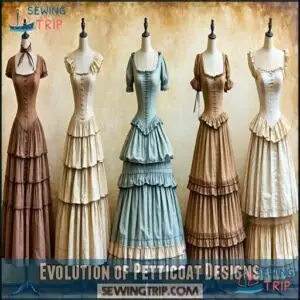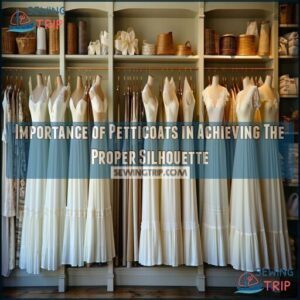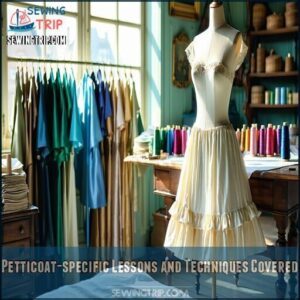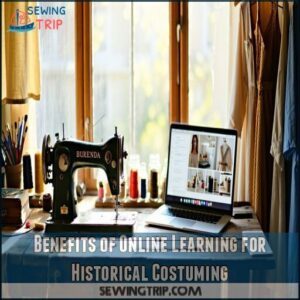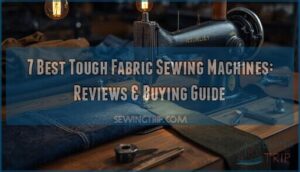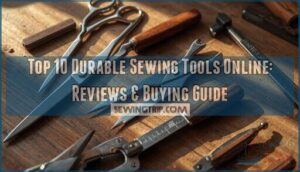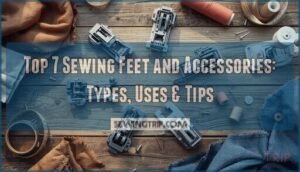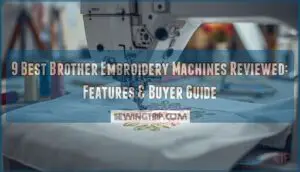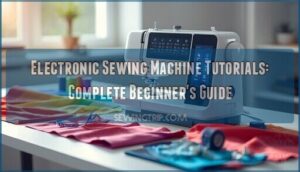This site is supported by our readers. We may earn a commission, at no cost to you, if you purchase through links.
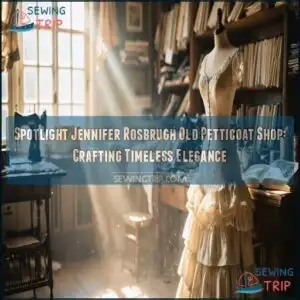
This passionate seamstress turned her Victorian fashion dreams into a business that provided authentic patterns and resources worldwide.
While the physical shop has closed, Jennifer’s expertise lives on through her Historical Sewing School online classes and Emma Lily Designs pattern line.
She’s the friendly guide you wish you’d had when you first tangled yourself in yards of petticoat fabric! Her techniques transform ordinary sewists into confident historical costumers who can create those perfectly poufed silhouettes that would make even Queen Victoria nod with approval.
Table Of Contents
Key Takeaways
- Jennifer Rosbrugh transformed her passion for Victorian fashion into the Old Petticoat Shop, a beloved business that served the historical sewing community for seven years before closing in December 2021.
- You’ll find her expertise lives on through Emma Lily Designs pattern line and her Historical Sewing School, where she makes complex historical costuming techniques accessible to sewists of all levels.
- Her courses teach everything from Victorian corset construction to petticoat-making techniques, with a focus on achieving authentic silhouettes and using period-appropriate materials.
- Her lasting impact on the historical costuming community includes democratizing historical fashion techniques, preserving traditional craftsmanship, and building a global community of enthusiasts who continue to share her knowledge.
Jennifer Rosbrugh Biography
You can’t talk about historical sewing without mentioning Jennifer Rosbrugh, whose passion for 18th and 19th-century fashion sparked a lifelong journey of crafting and teaching.
From studying authentic techniques to embracing Neo-Victorian elegance, she’s made history both stylish and approachable.
History isn’t just to be studied—it’s to be worn, with every stitch telling a story of elegance reborn.
Early Life and Inspiration
Jennifer Rosbrugh’s love for historical fashion had roots in her Childhood Creativity and Early Inspirations. Growing up, she seized every chance to stitch and create, shaping her Sewing Beginnings with needles, threads, and dreams. Her fascination with fashion history grew out of Family Influences, where stories and artifacts of the past sparked her imagination.
Her journey into historical costuming wasn’t just a path—it was a calling.
- Sewing brought joy and sparked her passion for reimagining costume history.
- Design Interests flourished, with antique styles influencing her vision.
- Family treasures inspired her, deepening an appreciation for fashion history.
- Each creation felt magical, stitching together elegance and nostalgia.
This passion later shaped the beloved Old Petticoat Shop.
Education and Training in Historical Sewing
With years of hands-on experience and an eye for detail, Jennifer Rosbrugh turned her passion into an extensive exploration of sewing education. Through the Historical Sewing School, she’s made learning historical sewing techniques approachable for everyone!
Whether it’s sewing certifications, pattern drafting, or mastering hand sewing and machine techniques, Jennifer’s online sewing classes cover it all. Her tutorials, paired with digital PDFs, focus on fabric selection and historical accuracy, making complex Victorian undergarments achievable.
You’ll find her teaching style clear and confidence-boosting. To guarantee success, understanding fabric properties is also key.
Ready to join the community? Immerse yourself in historical sewing with Jennifer’s expert guidance. It’s addictive!
Neo-Victorian Philosophy and Approach
Ever thought of blending Victorian elegance with today’s fast-paced world? That’s the magic of Neo-Victorian living—where 19th-century fashion meets mindful, sustainable practices with a modern twist.
Jennifer’s sewing philosophy embraces this fusion, turning corsets and petticoats into more than costumes; they’re a statement of ethical consumption and timeless beauty.
Her vision intertwines Victorian fashion with modern interpretation, showing how aesthetic values and technological integration can breathe life into vintage styles. It’s not just sewing; it’s a mission rooted in social commentary and ethical considerations.
Through her classes, she proves history isn’t old—it’s beautifully relevant and refreshingly innovative, making her approach to Victorian fashion a unique blend of past and present.
Old Petticoat Shop History
You’ll fondly remember the Old Petticoat Shop as the go-to treasure trove that served the historical sewing community for seven wonderful years before closing its doors in December 2021.
While the shop’s chapter has ended, its legacy continues through Emma Lily Designs where you’ll find exciting new patterns with modern tutorials to keep your sewing adventures stitched with possibilities.
The shop’s impact on the sewing community is a testament to its enduring legacy, and its memory will live on through the countless sewers it inspired.
Origins and History of The Shop
How did a passion for historical sewing transform into a beloved online shop?
For seven remarkable years, the Old Petticoat Shop served as a virtual haven for history-loving seamstresses seeking specialized patterns and authentic resources.
The shop’s journey began as Jennifer Rosbrugh’s natural extension of her expertise in vintage sewing and Victorian fashion. From its humble founding in 2014, it weathered early challenges to become a trusted cornerstone in the historical costuming community.
Though the Old Petticoat Shop closed its virtual doors in December 2021, its legacy continues through Emma Lily Designs, where Jennifer’s knowledge and creative vision live on.
Unique Offerings and Specialties
Walking into the Old Petticoat Shop was like stepping through a time portal where vintage elegance met modern craftsmanship.
Step through our doors and journey where time stops but creativity flows endlessly.
Before closing in December 2021, this treasure trove celebrated timeless fashion through a carefully curated collection of petticoats, vintage skirts, and historical patterns that captured the essence of bygone eras.
The shop’s unique offerings extended beyond ordinary sewing supplies:
- Hand-selected Cowboy Western petticoats that transported you to frontier adventures
- Custom-made petticoat pieces that whispered stories of Victorian ballrooms
- Classic Cotton Petticoats in rich black that formed the foundation of countless historical costumes
You’d find yourself surrounded by materials that breathed life into historical costuming projects—whether recreating a Jane Austen-inspired gown or crafting authentic bum pads using period techniques. You could even use hand sewn embellishments to add a unique touch.
The Old Petticoat Shop wasn’t just a store; it was where your antique clothing dreams took shape, guided by Jennifer’s expertise in pattern design and vintage sewing.
Curation Process for Vintage and Antique Pieces
The Old Petticoat Shop didn’t just collect vintage pieces—it breathed new life into them through a fastidious curation process that honored their historical significance.
- Cotton gloves were always worn when handling antique clothing to prevent oils from damaging delicate fibers
- Each textile underwent careful authenticity verification through period-appropriate construction techniques
- Restoration methods included gentle vacuuming with fiberglass screens and specialized cleaning for different fabrics
- Storage solutions featured acid-free boxes and muslin covers made from pre-laundered cotton
- Display techniques incorporated proper mounting to prevent structural damage
When restoring petticoats, Jennifer used traditional starching methods—soaking in starchy water rather than using spray starch—to achieve authentic period drape. Historical patterns were documented through detailed photography and measurements, preserving these techniques for future generations. The shop’s approach wasn’t just about preservation; it was about keeping history wearable and honoring the historical significance of each piece.
Historical Sewing Expertise
You’ll discover a treasure trove of historical sewing knowledge at Jennifer Rosbrugh’s Old Petticoat Shop, where time-honored techniques meet modern accessibility.
Her expertise transforms what could be intimidating 18th-century methods into approachable skills you can master, even if you’ve never sewn anything fancier than a pillowcase, using time-honored techniques.
Evolution of Petticoat Designs
From showcasing historical garments to revealing fascinating fabric innovations, Jennifer Rosbrugh’s shop built its reputation on understanding petticoat evolution.
You’ll discover how these undergarments transformed from simple 16th-century warmth providers into status symbols with decorative trims.
The 18th century brought quilted wool designs, while Victorian crinoline petticoats created those iconic voluminous silhouettes.
Regional variations emerged as social influences shaped decoration trends, and by the 20th century, lighter fabrics like nylon revolutionized historical undergarments, with the 1950s revival celebrating feminine historical costuming once again.
Materials and Techniques Used in Authentic Petticoats
Following the evolution of petticoat design, let’s explore what makes these historical undergarments truly authentic.
Cotton stands as the foundation of 19th-century petticoats, available in plain, embroidered, or starched varieties.
You’ll find most authentic pieces cut to match the skirt’s shape for ideal support.
While flared patterns offer historical accuracy, tube-shaped constructions provide a similar silhouette with less effort.
For horsehair petticoats (popular from 1840), cotton bands at the waist and hem deliver both structure and comfort.
To find the right period materials, consider online resources.
Your ideal dimensions? Aim for 30 inches at the top and 46 inches at the bottom, ensuring a similar silhouette with the right period materials and historical accuracy.
Importance of Petticoats in Achieving The Proper Silhouette
While perfect fabric choices matter, it’s the petticoats underneath that truly bring historical costumes to life.
These clever underpinnings create the foundation for every authentic silhouette.
Here’s why petticoats are the secret MVPs of historical dressmaking:
- Shape Creation – They build the era-specific silhouette from the ground up
- Volume Control – They add just the right fullness where needed
- Movement Management – They create that distinctive historical sway when you walk
- Temperature Regulation – They provide practical insulation in period-accurate ways
- Visual Impact – They transform a flat dress into a three-dimensional masterpiece
To guarantee durability, consider using flat felled seams for your petticoat construction.
Online Courses and Legacy
You’ll find Jennifer Rosbrugh’s legacy thriving through Emma Lily Designs, where her passion for historical sewing continues with modern tutorials and online classes.
Her shift from Old Petticoat Shop to digital offerings guarantees her expertise remains accessible, much like finding that perfect thimble you thought was lost forever in your sewing basket.
This transformation has transformed countless fabric-phobic beginners into confident costumers.
Overview of Victorian Corset Construction Course
From mastering historical techniques to creating authentic silhouettes, Jennifer Rosbrugh’s Victorian Corset Construction Course offers a thorough journey through 1860-80 corsetry.
This online class equips you with all the essentials of Victorian undergarment construction:
- Fabric selection and corset anatomy fundamentals for historical accuracy
- Practical busk setting and various boning techniques for proper structure
- Fitting refinements and seam placement to achieve period-specific styling
You’ll learn to construct corsets with both exterior and interior boning channels, providing a solid foundation for all your future historical sewing projects. Furthering your knowledge of the craft can be achieved through a Victorian corset course. Jennifer’s approach makes even challenging lacing methods and fitting challenges feel approachable for enthusiasts at any skill level, with a focus on historical accuracy and period-specific styling.
Petticoat-specific Lessons and Techniques Covered
Building on the corset fundamentals, Jennifer Rosbrugh’s petticoat lessons reveal the secrets of historical silhouettes.
Her tutorials walk you through each step with clarity you won’t find elsewhere.
| Technique | Material | Skill Level |
|---|---|---|
| Ruffling | Cotton | Beginner |
| Layering | Silk | Intermediate |
| Embellishing | Linen | Advanced |
| Volume Control | Mixed | All Levels |
You’ll learn fabric selection that’s period-appropriate while mastering the art of creating volume without the dreaded "lampshade effect".
Jennifer’s tips on petticoat construction feel like having a sewing friend right beside you, laughing about those first awkward attempts we’ve all made.
For those seeking further instruction, consider exploring available petticoat sewing products.
Benefits of Online Learning for Historical Costuming
Jennifer Rosbrugh’s online courses revolutionize historical costuming education with unmatched accessibility.
From your living room, you’ll master period techniques that once required in-person apprenticeships.
- Flexibility to learn at 3am in your pajamas—perfect for busy schedules
- Cost savings on travel while accessing expert instruction
- Skill development through detailed sewing tutorials and immediate video replays
- Community building with fellow costume enthusiasts worldwide
"I finally made stays that fit!" is a common victory celebration.
Future Ventures and Impact
You’ll find Jennifer Rosbrugh’s evolution from Old Petticoat Shop to Emma Lily Designs is shaping the future of historical costuming, with her new pattern line and online classes stitching together tradition and innovation.
Her lasting impact on the sewing community continues to inspire countless creators who, like you, might once have struggled to tell their bum pad from their false rump, and find historical costuming more accessible.
Contributions to The Historical Costuming Community
While online courses opened doors for many learners, Jennifer’s greatest legacy lives in the vibrant historical costuming community she nurtured.
She didn’t just sell patterns—she built connections that transformed how enthusiasts approach their craft.
| Community Impact | Real-World Results |
|---|---|
| Knowledge sharing | Elevated accuracy standards |
| Mentorship programs | Launched careers |
| Event participation | Created lifelong friendships |
| Inspiration source | Sparked creative innovations |
| Educational resources | Preserved traditional techniques |
You’ll find her influence at every costuming event, where sewists trade "Jennifer taught me this stitch!" stories while adjusting each other’s historically accurate petticoats with knowing smiles.
Sewing’s evolution reflects the shift to industrialization, impacting apparel production and techniques.
The historical costuming community and vibrant connections Jennifer built continue to inspire and educate, leaving a lasting legacy in the world of sewing and beyond, with a focus on elevated accuracy standards and preserved traditional techniques.
Impact on Modern Historical Costuming
Beyond simply reviving old styles, Jennifer’s work has transformed the historical costuming community.
Where once period-accurate garments seemed intimidating, her accessible techniques democratized historical fashion for makers at all skill levels.
You’ll find her influence in how modern costumers approach authenticity with confidence—her step-by-step methods making even complex Victorian silhouettes achievable for everyday sewists.
Through the Old Petticoat Shop, she created a bridge between preservation and practical application, helping you understand not just how to construct historical garments, but why specific techniques matter.
Her approach fostered remarkable community growth, connecting enthusiasts globally who share inspirations and solutions.
By making historical sewing accessible to modern hobbyists, Jennifer guaranteed these time-honored techniques wouldn’t just survive—they’d thrive in today’s creative landscape.
Lasting Influence on Future Generations
While today’s costuming world evolves with modern tools, Jennifer Rosbrugh’s legacy reaches far beyond contemporary influences.
Her work’s ripple effect through the sewing community can’t be overstated.
The lasting impact of the Old Petticoat Shop continues through:
- The transmission of nearly-forgotten historical techniques to young costumers
- Accessible education that breaks down class and geographic barriers
- Community growth that connects isolated enthusiasts to supportive networks
These contributions guarantee sewing traditions don’t just survive—they thrive. Like seeds planted in fertile soil, Jennifer’s sewing heritage blooms in unexpected places, inspiring tomorrow’s costume historians with yesterday’s elegant craftsmanship, and ensuring her legacy has a lasting impact on the community, leaving a lasting legacy.
Frequently Asked Questions (FAQs)
What are petticoats called now?
In modern parlance, petticoats remain petticoats in historical costuming circles.
They are also referred to by other names, depending on their style, structure, and the era they’re designed to represent, such as slips, underskirts, or crinolines.
When did petticoats go out of style?
Petticoats gradually lost their everyday appeal after the late 19th century.
Though you’ll find they enjoyed a fabulous comeback during the 1950s thanks to Christian Dior’s "New Look."
They’ve swished in and out of fashion ever since!
What does the petticoat symbolize?
The unassuming undergarment in your historical wardrobe carries more weight than meets the eye.
You’ll find petticoats symbolize femininity, social status, and modesty across different eras, while also representing the layers of female identity.
What year did the petticoat come out?
You’ll find petticoats first appeared in the 14th century, when they were worn by both men and women as "petticotes."
They evolved into women’s underskirts during the 15th century, creating those bell-shaped silhouettes you’ve probably seen in historical dramas, which were a result of wearing petticoats.
What was the purpose of the petticoat?
You’ll find that petticoats served as an essential undergarment to create volume beneath women’s skirts and dresses.
They’ve helped shape fashion silhouettes throughout history, while also providing warmth during cooler seasons, and can be seen as a crucial element in understanding the evolution of fashion.
How many petticoats should I wear?
For historical accuracy, you’ll want 2-3 petticoats for everyday wear and up to 5 for formal occasions.
The number depends on your desired silhouette and the time period you’re recreating.
You’ll know it’s right when it feels authentic!
Do you offer custom petticoat designs?
Creative custom petticoat crafting isn’t currently offered, but don’t let that ruffle your plans!
There’s plenty of delightful DIY guidance, making it easy to tailor your own styles with charm and historic flair.
What fabrics do you typically use?
You’ll love working with cotton organdie for petticoats, duchess satin for elegant projects, and period-correct linens that breathe while you’re dancing away.
Jennifer’s tutorials often recommend fabric choices that won’t leave your wallet crying, which is a key consideration for many crafters, and her advice on elegant projects is particularly valuable.
What is your petticoat alteration policy?
You can fold, remake, and repurpose your petticoats easily with us.
We’ve designed them so excess fabric at the waistline accommodates different hip structures—from bumpads to panier—keeping your historical silhouette perfectly à la mode, with the silhouette being the key focus.
How long is your average petticoat construction time?
You’ll find your petticoat takes approximately 27 hours to construct with traditional gathering methods.
But you can dramatically cut that time to just 5 hours using a ruffler foot—a real sanity-saver for those miles of fabric!
Conclusion
Like a master gardener who cultivates rare blooms, Jennifer Rosbrugh has grown a legacy beyond the Old Petticoat Shop.
You’ll find her influence stitched into the fabric of modern historical costuming. Through her online school and pattern designs, she’s empowered countless sewists to embrace Victorian elegance.
When you spotlight Jennifer Rosbrugh’s Old Petticoat Shop journey, you’re celebrating not just her past, but the future she’s shaped for historical fashion enthusiasts worldwide, and recognizing her as a master who has empowered countless sewists.
- http://emmalilydesigns.com/
- https://classes.historicalsewing.com/
- https://www.american-duchess.com/womens/shoes-18th-century/dunmore-18th-century-shoes-oxblood
- https://drive.google.com/file/d/1cSENAIOeigfveEfwTeQdUOyvLd_-Gml_/view?usp=sharing
- https://www.eventbrite.com/e/historical-costumer-meetup-picnic-tickets-45444621085



